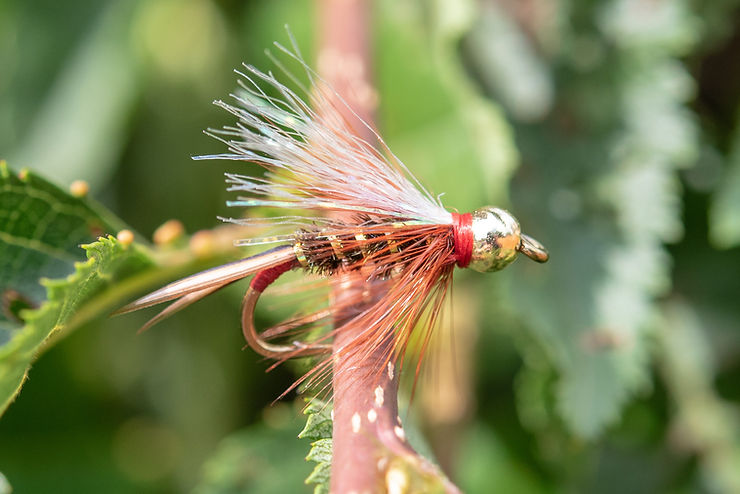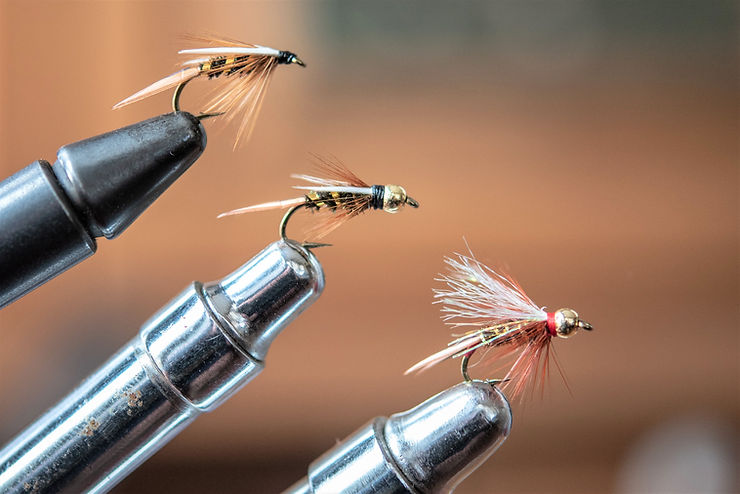The Fly Formerly Known As Prince

In order to understand The Fly Formerly Known As Prince, we first have to talk about its predecessor, the Prince Nymph. A creation of Don and Dick Olson, who called it the Brown Fork-Tailed Nymph, the Prince Nymph was renamed by the guy who made it famous, Doug Prince. The Prince is one of those patterns that represents everything and nothing at the same time.
I discovered the Prince Nymph and the artist Prince about the same time, in the mid-1990s. Maybe that’s why I find it almost impossible to fish with a Prince Nymph and not hum a Prince song. In fact, I’d argue that the Prince Nymph is most effective that way. Sure, it makes no sense, but when you find something that works, why change?
The Prince is an old pattern that falls in and out of vogues, as classic nymphs often do, because there are so many newer, flashier alternatives to choose from. It seems like there are two categories of fly fishermen, those without a single Prince in their box, and those who carry the nymph but rarely use it. However, its influence is substantial, and many new patterns are simply Prince variations, such as the Psycho Prince, Hot Wire Prince, and Princes of just about any color.
Very few traditional patterns have aged well, meaning that their original versions are still the preferred versions. Exceptions would be the Hare’s Ear (invented in 1910) and the Pheasant Tail Nymph (invented in 1958), both of which are so general that they do a fantastic job of matching any handful of insects. In fact, if you saw a Pheasant Tail in a police lineup with real mayfly nymphs, it could easily be mistaken and arrested for impersonating a Sulphur, March Brown, or any number of Callibaetis nymphs.
The Hare’s Ear and Pheasant Tail Nymph are also tied in numerous styles and variations, but most everyone would agree that their original versions remain just as effective in almost any nymphing situation. That’s not necessarily the case with the Prince Nymph. Within just a few years (maybe less) after gaining popularity, the nymph was fundamentally changed with the addition of a gold bead. Nowadays, it seems like Prince Nymphs tied without gold beads are scarce, but that could probably be said about most patterns. Fly fishing techniques have evolved so much that its hard to deny that flies with beads catch more fish, and flies without beads have been relegated to niche roles.

(Photo top to bottom: The original Prince, Beadhead Prince, and The Fly Formerly Known As Prince)
There was a time when I thought that I could catch trout anywhere, anytime, as long as I had an assortment of Princes on hand. And for a while, it was my first choice, the head honcho of my fly box. Maybe it was the year or the stream I was fishing, or maybe just that I was 15 and naïve, but for several seasons it seemed like I absolutely killed it with a size 12 Prince Nymph.
Oddly enough, when I open my fly box nowadays, my finger almost always lands on a lineup of various Prince Nymphs, and then keeps going down the rows to something else. I’m not even sure why, but part of me wonders if it’s because I’ve actually gotten better as a fly tyer over the years.
In my teens, I wasn’t particular about proportions or if a fly looked pretty. All I cared about was whether it looked buggy. I tied my Prince on a standard dry fly hook, gold bead, a bulky body of peacock herl, brown hackle feathers for a tail because I didn’t have any brown goose biots, brown hackle that kind of stuck out at odd angles like a botched haircut, and clipped white duck wing for the wings. Fair to say my Prince was a mess, but dang if it didn’t catch fish, and it seemed like the neater, more proper, and better my Princes started to look, the less they actually produced.
I think this goes back to the Prince being an attractor fly. I tend to have more success with attractors that are suggestive rather than realistic. After all, they don’t specifically match anything anyway, so who cares about perfect proportions, hackle, or even if you’re using the exact materials called for in the recipe. I don’t think the fish mind much, either.
(Although I just got this image in my head of feeling a tug on my line and when I pull it in there’s a note attached to the hook that reads: “Next time use goose biots.”)
Fly tyers are nothing if not innovative. Technology has drastically increased the variety of materials over the years, especially in the form of synthetics, which has opened up a whole new world of variations based on old themes. Holographic paper is a great example. Somewhere along the line, someone got the idea to cut holographic paper into the shape of goose biots and use it as the wings on a Prince Nymph, and so The Fly Formerly Known As Prince was born.
My introduction to The Fly Formerly Known As Prince came on a dreary March day. I’d lost the guide’s last Pheasant Tail to an overhead tree. He was scratching his head as he scoured his fly box trying to figure out what might work and, in my mind at least, was expendable in case I got crazy again with my back cast. He came up with this fly, which I examined closely, noting that the wings consisted of strands of holographic flash rather than paper. He’d tied the fly himself, and like any true fisherman, had substituted exact materials with whatever he’d had on hand.
We continued down the river in the drift boat, and it all came back. I was 15 again, flinging a Prince Nymph with confidence. And when I landed The Fly Formerly Known As Prince perfectly behind a midstream boulder and saw the dark shadow of a giant wild brown trout come out and inhale the fly, I reared back on my rod. “Fish on!”
I didn’t even realize until then that I’d been humming. Old habits die hard, even after 25 years.
Since that day, The Fly Formerly Known As Prince has become a staple in my fly box. Like my guide, I, too, have opted for holographic flash for the wing instead of cut-to-shape holographic paper. First, I like the extra movement of the flash strands, and second, it’s just much less hassle and easier to work with. If you need a third reason, I think the flash material helps the fly blur the boundary between nymph and emerger, and in my experience, that’s rarely a bad thing.
The Fly Formerly Known As Prince has a characteristic that many “modern” patterns seem to have, and that’s the addition of a hot spot – in this case, the use of red thread instead of black, which provides a nice color contrast. In truth, once you get used to tying and fishing with The Fly Formerly Known As Prince, the original Prince Nymph seems quite ordinary. I may never use a plain old Prince again, but I’ll always carry a couple in my fly box if for no other reason than to remind myself of those glory days so many years ago.

Recipe for The Fly Formerly Known As Prince.
Hook: 2xl nymph hook such as the Daiichi 1710
Bead: Gold, brass or tungsten
Thread: Red 8/0
Tag: Red thread
Tail: Two brown goose biots, splayed to create a forked tail.
Body: Peacock herl
Ribbing: Flat gold tinsel, but sometimes I use a holographic tinsel for this too or something flashy like pearl flashabou
Wing: Two pieces of holographic film cut in the shape of biots or strands of holographic flash
Hackle: Brown hen saddle
